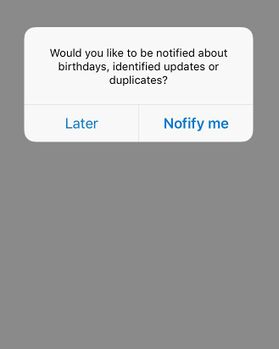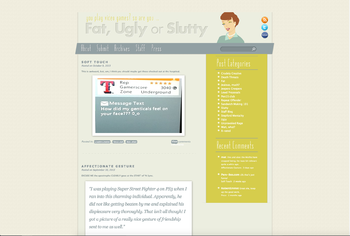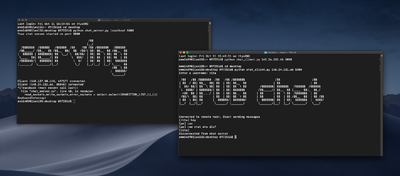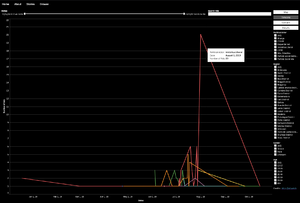User:Rita Graca/gradproject/project proposal 5: Difference between revisions
Rita Graca (talk | contribs) No edit summary |
Rita Graca (talk | contribs) No edit summary |
||
| Line 28: | Line 28: | ||
<gallery widths=350px heights=350px> | <gallery widths=350px heights=350px> | ||
File:darkpatterns_hall_of_shame.jpg|"Dark Patterns are tricks used in websites and apps that make you do things that you didn't mean to, like buying or signing up for something." In this case, ''No'' option is unavailable. From [https://www.darkpatterns.org/hall-of-shame darpatterns.org] | File:darkpatterns_hall_of_shame.jpg| <pre>"Dark Patterns are tricks used in websites and apps that make you do things that you didn't mean to, like buying or signing up for something." In this case, ''No'' option is unavailable. From [https://www.darkpatterns.org/hall-of-shame darpatterns.org] | ||
File:Fatuglyslutty.png | A blog that collects and displays racist, sexist and homophobic comments that female and queer gamers have received online. The users police online spaces with their own rules. | File:Fatuglyslutty.png | A blog that collects and displays racist, sexist and homophobic comments that female and queer gamers have received online. The users police online spaces with their own rules. | ||
Revision as of 14:47, 28 November 2019
WEAPONISED SOCIAL INTERFACES
Graduation Project Proposal
28 November 2019
What do you want to make?
I want to visualise how users assert their agency inside social interfaces. Using my background as a designer, I intend to compare distinct platforms to understand how their structure allows different ways of protesting.
My daily life is mediated through interfaces that are getting harder to recognise and understand. The personalisation of my social media accounts leaves less and less room for discovery, performance and speculation. I'm always bounded to my profile, shoved with things to buy, and to feel like a target every time becomes exhausting. The lack of control I experience online encouraged me to consider different alternatives.
The most honest way for me to look into these problems is from where I stand. I'm already subscribed to the biggest platforms. What happens if I resist the biased discourse, but from the inside? It's stimulating to reverse the narrative of platforms manipulating users. To be able to see how users can use the same features to their interest.
There are several ways to reclaim user agency on social media. Demanding accountability through laws, writing manifestos, using DIY tactics, building low tech devices, sharing memes. One I find especially controversial is call-out culture. Calling-out toxic behaviours, policing online spaces with the users' own rules, protesting for change. They all demonstrate a wish for users to be heard and stay in control. Ineffective politics pushes users to react, transforming shaming in meaningful political participation. (Ingraham and Reeves, 2016) I want to focus on contentious actions such as online policing, call-out and shaming because they are the most extreme examples of users longing to be heard.
Online protesting uses social media to spread quickly and gain visibility. By finding their way to the trending topics, through hashtags, using location tags. These are features of specific social media platforms.
Questions start to linger...
Who is responsible for social platforms?
Do actions of protesting change something or do they give an illusion of power?
How are interfaces amplifying these movements?
Is manipulation revocable?
"Dark Patterns are tricks used in websites and apps that make you do things that you didn't mean to, like buying or signing up for something." In this case, No option is unavailable. From darpatterns.org
What is your timetable? September, October — Ground my interests, make clear what I want to work on by researching and finding projects. Fast prototyping. November, December — Project Proposal is written so my scope is set. Have a more specific direction for the prototypes. Who is my audience? Engage with the users: going from observer/scraper to participant. January — Allow the feedback from the assessment and the break to feed new inputs to the project. Organize a workshop (Py.rate.chnic sessions) which will allow other people to experiment and talk about the project. February, March — Put my prototypes together to create a bigger platform. The project will expand from small experiments to a combined project. How will people engage with my project? Think about distribution, amplification and contribution from others! April, May — Written thesis is delivered. Focus on the project. Test my prototypes, perform them or put them online. Is it useful to organise more workshops or conversations around the subject? June, July — Finish everything: conclusion of the final project. Prepare the presentation. Why do you want to make it? Feels urgent. When diving into the subject of mainstream social media, the amount of noise is overwhelming. The lack of credibility of the media casts a shadow on genuine social movements and mobilisations online. There's urgency in amplifying authentic conversations. Feels contemporary. The users have been demanding more reliable platforms and the companies picked out the trend by providing some changes. In April TikTok added two new features to promote a safer app experience. In July Instagram tested hiding its likes in several countries to benefit their users’ experience. Youtube promised to release soon new features in an attempt to be more transparent with their algorithms. It’s true that the real effects of these features are debatable and also part of well-thought marketing strategies. However, they show the audience is engaging with this type of discourses. Feels like I can join the conversation. The interface and its features gain social and contextual meaning, through subtleties or bigger movements. As a designer I can have a critical look at how these interfaces are built. Who can help you and how? Marloes de Valk, because of her knowledge on persuasive design, especially with the connection with Impakt festival. The Impakt festival itself can stimulate my research. The programme for this year is called Speculative Interfaces and it will investigate the interaction and relationship between technology and humans, and how this relationship can alter behaviours. I will attend two days of the festival. Past Xpub students like Lucia Dossin and Lídia Pereira, which have work on similar topics. Joana Moll and Femke Snelting, with the connection with Critical Interface Politics. This year-long research is full of useful resources. Includes the Critical Interface Toolbox and also related to the Interface Manifesto. Olia Lialina, an artist with a lot of work on web interfaces. I will be in her workshop in November, which explores early web pages through the interface of The GeoCities archive. Approximately 382,000 home pages. Xpub staff and students, for the variety of useful input. Relation to previous practice I understand that design shapes our ability to access, participate in, and contribute to the world (Holmes, 2018). As a graphic designer myself, I always was interested in the biases I implement in the things I build. Especially when those determine who can engage and how they do it. Last year we discussed decentralised networks on Special Issue 8: The Network We (de)Served, and this build up my interest in the subject. I understood how creating new platforms and looking for alternatives reveals the desire for bottom-up changes and more active end-users. It became clear that centralised models of technology propagate limited ideas, and those ideas shape our society. As a project for that same Special Issue, I prototyped some tools that helped me visualize the ideas I was discussing. To turn the research into tools is something that I intend to continue for this final project. Relation to a larger context The urge to take control of our online spaces reveals the present concern over software pervasiveness, automation and accountability. Software is found on diverse objects and systems but is not always perceptible or understandable. In this way, software studies try to open the black box, looking for its methods and routines. (Kitchin and Dodge, 2011) However, opening the black box is not enough. Information without context, processing and analysing, is not accessible to the users. Furthermore, demanding transparency from big social media platforms doesn't provide the agency we seek as the ability to see doesn't mean the power to govern it. (Ananny and Crawford, 2016) At the same time, the increasing automation of our systems means even less control and less accountability. To overcome these difficulties, it makes sense to get around the software and focus on the relationship between the system and its users. Several projects work to visualise data, as a method for understanding relevant connections. Projects such as Ad.watch which compiles and visualises datasets of political ads on Facebook and Instagram to display the dubious relations between politics and social media platforms. Other projects decide to engage with the interface itself. Through plugins, add-ons, small robots and DIY techniques. Some authors encourage resistance arguing for alternative design practices through glitches, imperfect features, disturbing or illogical processes. (Hollanek, 2019) All these strategies support more user agency. As social media platforms become ubiquitous, spreading its convictions to billions of people, it is important to amplify these movements outside the tech world. It only makes sense to be part of a community that makes use of platforms in their own terms.
References Ananny, M. and Crawford, K. (2018) Seeing without knowing: Limitations of the transparency ideal and its application to algorithmic accountability. New Media & Society, 20 (3): 973–989. Century of the Self (2002) Film. Adam Curtis. England, BBC. DNL# 13: HATE NEWS. Keynote with Andrea Noel and Renata Avila (2018) Film.
Available at: https://www.youtube.com/watch?v=l2z6jP0Ynwg&list=PLmm_HP_Sb_cTFwQrgkRvP8yqJqerkttpm&index=3 (Accessed: 12 November 2019). Dubrofsky, R.E. and Magnet, S. (2015) Feminist surveillance studies. Durham: Duke University Press, 221–228. Hollanek, T. (2019) Non-user-friendly. Staging resistance with interpassive user experience design. APRJA, 8, 184–193 Holmes, K. and Maeda, J. (2018) Mismatch: how inclusion shapes design. Simplicity : design, technology, business, life. Cambridge, Massachusetts ; London, England: The MIT Press. Kitchin, R. and Dodge, M. (2011) Code/space: software and everyday life. Software studies. Cambridge, Mass.: MIT Press, 3-21. Lialina, O. (2018) Once Again, The Doorknob. On Affordance, Forgiveness and Ambiguity in Human Computer and Human Robot Interaction.
Available at: http://contemporary-home-computing.org/affordance/ (Accessed: 17 September 2019). Shaw, T. (2017) Invisible Manipulators of Your Mind., 20 April.
Available at: https://www.nybooks.com/articles/2017/04/20/kahneman-tversky-invisible-mind-manipulators/ (Accessed: 11 November 2019). Williams, J. (2018) Stand out of our light: freedom and resistance in the attention economy. Cambridge, United Kingdom ; New York, NY: Cambridge University Press. Winner, L. (1980) Do Artifacts Have Politics? Daedalus, 109(1), 121–136





